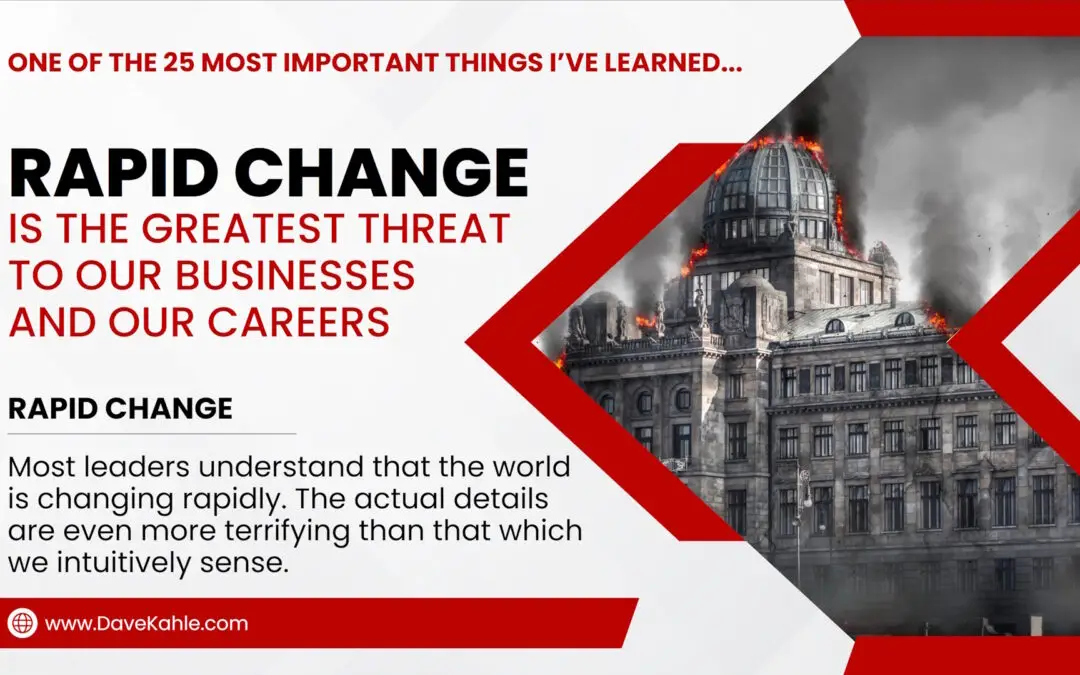Listen to this post's Podcast
Recently, one of the members of my CBIG groups suggested I make a list of the 20 most important things I’ve learned in my 30 years of experience working with B2B sales organizations.
So, I created a list and discovered it to be far longer than 20 items. To narrow down the long list, I applied these four criteria:
1. It had to be an important lesson – one which has the potential to dramatically impact a person, a sales team, or a business — not superficial or trivial.
2. It had to arise out of my personal experience. In other words, not something that I garnered from a book, or borrowed from someone else. Something I’ve learned in the trenches.
3. It had to have been tested in the caldron of real-world experience. No blue- sky stuff.
4. I had to unwaveringly vouch for its validity. These are concepts and lessons that I would stand behind.
Applying these four criteria, I narrowed the list down to 25. In no particular order, here’s one of them. Rapid change is the greatest threat to our businesses and careers.
Most leaders understand that the world is changing rapidly. The actual details are even more terrifying than that which we intuitively sense.
Our generation is facing change to such a degree that it is unprecedented in the history of mankind. Of course, individuals and small groups of people have lived through mind-boggling change. Time of war and natural disasters, for example, have uprooted groups and transported them to a condition light year away from where they started. But these changes have typically been the consequences of an event. After the event passes, the folks settle into a new situation.
Today, however, the changes are pervasive, systematic and continuous. Let me illustrate. The root cause of our changing situation is the increase in information. As information expands, it seeps into every area of our economy and culture and causes change. So, to measure change, track the growth in information.
There is a measurement called ‘the total amount of information available to mankind.” It is estimated that, in the year 1900, the total amount of information was doubling every 500 years. That meant that the world was changing relatively slowly. Our great grandparents, for example, probably lived in the same kinds of houses their parents did, worked at the same kinds of jobs, and interacted within the same kinds of social structures.
Now, fast forward to the year 2,000. The total amount of information available to mankind was doubling every two years. Imagine the growth in the pace of change! We went from it doubling every 500 years to it doubling every two years. As a result, the world of the year 2,000 was changing much more rapidly than the world in 1900.
But what about now? Estimates indicate that the total amount of information doubles about every 30 days. Is it any wonder that we feel like the ground that we stand on is shaking? We’re overwhelmed and confused.
Richard Swensen, writing in his book, Margin, had this observation to share:
“The spontaneous tendency of our culture is to inexorably add detail to our lives: one more option, one more problem, one more commitment, one more expectation, one more purchase, one more debt, one more change, one more job, one more decision. We must now deal with more ‘things per person’ than at any other time in history.”
That Margin was published in the year 2000 adds even more emphasis to the speed of change today.
One can’t help but conclude that there has never been a generation of businesspeople who have had to deal with the pace of change moving as rapidly as our generation. It truly is unprecedented.
The potential consequences
Look around us and we see products that have become obsolete almost overnight, (remember the I-pod) and companies come and go (where’s Howard Johnson’s these days?). Disruptive technologies upend entire industries in the blink of an eye. (Anyone want to invest in taxi companies these days?) And now, the emergence of AI portends to usher in a world dramatically different than it was just a year ago.
While we can and do react to specific instances of change that impact us, few of us recognize that the pace of change itself is the greatest threat. We can, for example, respond to a new competitive product. But more important than that specific instance of change, we need to recognize that the pace of change will bring ever more new competitive products. Today’s instance is just today’s instance.
It’s like a piece of driftwood being swept along by an ocean current. We can see and respond to the driftwood, but the underlying current is far more extensive and powerful.
That powerful current threatens to upend our jobs, transform our industries, and warp our culture. The rapidly increasing pace of change is the single biggest threat to our businesses and our careers – and our personal lives – that we will face for the balance of our lives.
If we don’t effectively manage change, we risk our organizations and our lives being upended and rendered obsolete before we can respond. There was a time when an organization prided itself on being quick reacting. Today, if you wait to react, you are probably behind the curve.
Leaders need to build disciplines and processes in their organizations that pro-actively identify the ‘next thing’ before it hits. Unprecedented change calls for new thinking.
Related Resources



